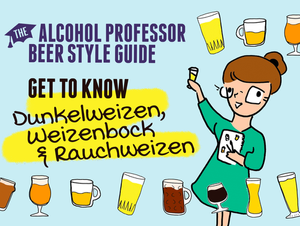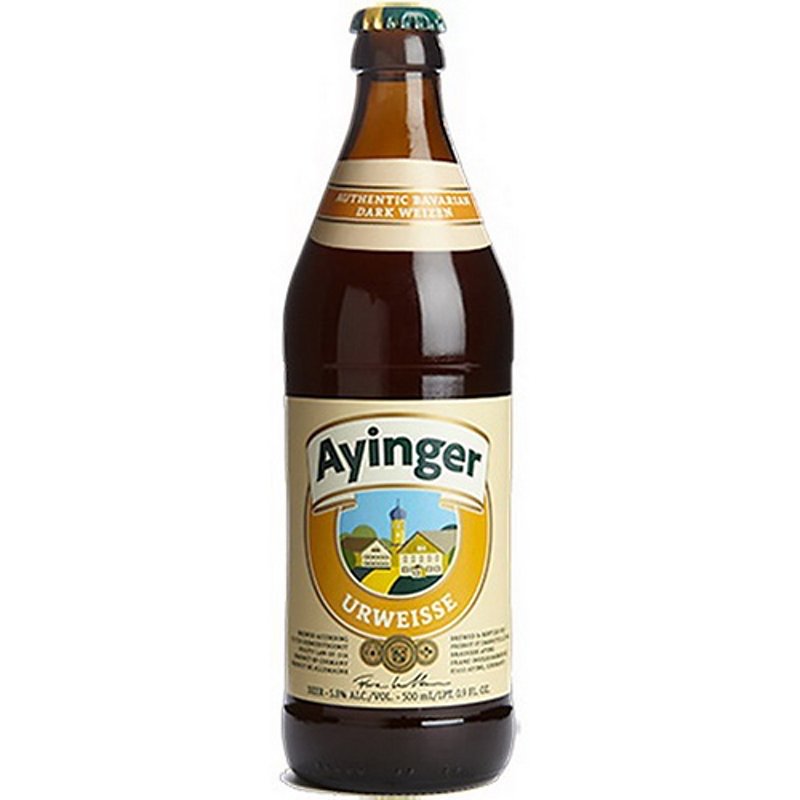Get to Know Dunkelweizen, Weizenbock & Rauchweizen with Em Sauter
While the hefeweizen is the most known wheat beer from Germany, there are others from Germany that deserve your attention. The similarities of all these beers are that they all utilize the same hefeweizen yeast strain so you’ll find that banana and clove note in all these other styles.
Dunkles Weissbier or Dunkelweizen
First up, the Dunkles Weissbier or Dunkelweizen. Dunkel is the German word for “dark” so this is a darker version of the hefeweizen. Essentially the same beer as a hefeweizen and served in the same glass but made with darker grains. The grist bill for this beer is 50% wheat malt like its lighter relation but the remaining grains can include Munich, Vienna and caramel wheat malts and perhaps some lighter barley like pale malt as well. Dunkelweizen is more traditional as most beers back a few centuries would have been darker. Take a look at Schneider’s amber colored original hefeweizen to see the connection to history and how the style has changed over the years.
Think of the dunkelweizen as drinking caramel drizzled banana bread. Since you are adding darker malts to this, there’s a caramel and toast note that adds a “baked” element to this beer. I like it almost more with a brat than a hef because the salty/sweet contrast is stronger.
Weizenbock
Looking for something stronger in terms of ABV? Try the weizenbock. It’s the only “bock” style of beer that’s brewed with ale yeast (all other bocks are lagers), and is only named “bock” to denote the higher alcohol strength. It utilizes the same yeast strain as both lower ABV options and can be light or dark in color. It’s brewed the same way as hef or dunkelweizen, just brewed with more wheat malts and other malts (can really be any base malt - do you want a lighter weizenbock or a darker weizenbock?) to get the ABV higher. Schneider even brews an “eis” or “ice” distilled version that’s even higher in ABV.
Weizenbocks show that in winter, wheat beers still have a place. The banana and clove flavors work with the alcohol warmth really well. Weizenbocks will have more fruit notes like fig or other stone fruits due to the fermentation or the darker grains used. I love this beer on its own after a big meal while the snow falls.
Rauchweizen
Want to get crazier? Head over to Bamberg to try a “rauch-weizen” or smoked wheat beer. Schlenkerla in Bamberg, Germany brews a “weizen” that’s made the traditional way of a hefeweizen but uses its smoked malt in place of pilsner malt. The result is a unique, smoky beer that will turn some heads. This is as crazy as hefeweizens go in Germany but craft breweries are definitely pushing the envelope of what a “hefeweizen” can be with fruit additions and other experimentations in other places around the globe.
Beers to try
Ayinger Ur-Weisse
“Ur” means “original” so this is Ayinger brewery’s original wheat beer and so of course it’s a dunkelweizen although more amber than more darker dunkels. This is the first beer I ever reviewed when I started my website “Pints and Panels” so it has a soft spot in my heart. Utterly drinkable and ready for any type of grilled foods.
Schneider Avenitus
Schneider are the wheat beer experts and they’ve been brewing this wheat “doppelbock” (their words) since the early 20th century. At 8.2% - this beer is the go-to when you are looking for wheat beers when the temperature drops.
Schlenkerla Rauchweizen
The only rauchweizen I know of (I’m sure there are American interpretations) - Schlenkerla’s rauchweizen is not for everyone but those who love the smoke are going to be smitten with this interpretation of a wheat beer.




